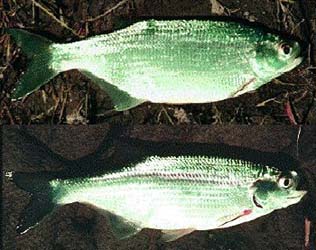Hiodon tergisus
Mooneye
Guo-Qing Li and Mark V. H. WilsonIntroduction
The mooneye, Hiodon tergisus Lesueur, one of only two living species in the genus, is like its sister species found in the fresh waters of the interior of North America, but is perhaps less widely distributed, occurring from Alberta, Saskatchewan, and southern Manitoba and the James Bay lowlands in the north (also in the Great Lakes), to Alabama and Arkansas in the south.
Mooneye usually prefer clear waters of lakes, ponds, and rivers, frequenting shallow habitats. Foods include aquatic invertebrates and small fishes, as well as flying insects that fall in the water and are taken by mooneye at the surface, usually in the evening and at night.
Mooneye live up to 11 years and mature sexually at 3-5 years of age.
Like goldeye they are taken by both sport and commercial fishers but are not of great commercial importance.
Characteristics
Mooneye differs from goldeye in the absence of the fleshy keel in front of pelvic fins (it extends only between the pelvic and anal-fins). The dorsal-fin originates in front of the anal-fin origin, and the mouth extends posteriorly to about the middle of the orbit.
Other characteristics include:
- The vertebral column consists of 55-58 vertebrae (vs. 58-63 in Hiodon alosoides and 52-53 in †Hiodon consteniorum).
- The anal-fin contains 26-30 principal rays (vs. 31-33 in Hiodon alosoides and 18 in †Hiodon consteniorum). The fin is supported by 27-31 anal pterygiophores (vs. 31-36 in Hiodon alosoides and 20 in †Hiodon consteniorum).
- It has a relatively shorter predorsal length, a shorter anal-fin base, a relatively higher body depth, and a longer dorsal-fin base for its size than Hiodon alosoides.
In addition, Hiodon tergisus differs from Hiodon alosoides and †Hiodon consteniorum in the following ratios:
- Standard length to body depth ratio about 3.0-3.1 (vs. 3.3-3.4 in Hiodon alosoides and 3.3-3.6 in †Hiodon consteniorum).
- Predorsal length to preanal length ratio about 0.92-0.93 (vs. 1.06-1.11 in Hiodon alosoides and 0.83-0.84 in †Hiodon consteniorum).
- Anal-fin base length to dorsal-fin base length about 2.0 (vs. 2.74-3.12 in Hiodon alosoides and 1.24-1.35 in †Hiodon consteniorum) (see Li and Wilson, 1994).
References
Coad, B. W. (1995). Encyclopaedia of Canadian fishes. Canadian Museum of Nature, Ottawa. 928 pp.
Nelson, J. S. (1994). Fishes of the World (3rd edition). John Wiley and Sons, New York. 600 pp.
Nelson, J. S. and M. J. Paetz (1992). The fishes of Alberta (2nd ed.). University of Alberta Press / University of Calgary Press, Edmonton/Calgary. 437 pp.
See the Hiodon page for other references.
About This Page

Chinese Academy of Sciences, Beijing , China

University of Alberta, Edmonton, Alberta, Canada
Correspondence regarding this page should be directed to Guo-Qing Li at
Page copyright © 1998 and
All Rights Reserved.
Citing this page:
Li, Guo-Qing and Mark V. H. Wilson. 1998. Hiodon tergisus. Mooneye. Version 01 January 1998. http://tolweb.org/Hiodon_tergisus/15148/1998.01.01 in The Tree of Life Web Project, http://tolweb.org/










 Go to quick links
Go to quick search
Go to navigation for this section of the ToL site
Go to detailed links for the ToL site
Go to quick links
Go to quick search
Go to navigation for this section of the ToL site
Go to detailed links for the ToL site